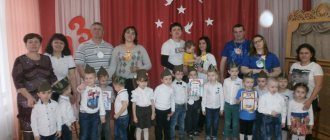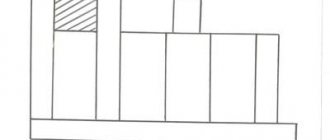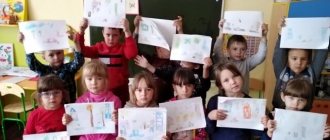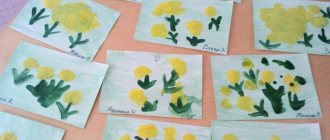Preparing for a drawing lesson “Clothes, shoes and hats” with children 4–5 years old
The topic “Footwear and clothing” in the middle group is carried out in two areas of work in fine arts:
- subject drawing,
- decorative drawing.
To make the lesson fun and productive for five-year-olds, it is necessary to prepare materials and plan children’s activities in accordance with their age and personal characteristics.
Even seemingly ordinary objects can interest children; they like to depict something familiar
Materials and basis for drawing
For classes you will need:
- Paints: It is preferable to use gouache, since the paint is easy to pick up on a brush and lies smoothly on the paper.
- Watercolors are more difficult for children 4–5 years old to type, the images may blur, so more control over the actions of the pupils is required.
- 1/2 album sheet,
Paints and colored pencils are the main materials for drawing clothes and shoes in the middle group
Giving children 4-5 years old markers is a bad idea. The pencil develops the skill of drawing with different pressure to obtain the desired color intensity. Felt-tip pens always draw a bright line on paper. In addition, children often stain their skin, clothes, and work area; stains from felt-tip pens are not easy to wash off.
Techniques and drawing techniques
Painting techniques:
- drawing straight and wavy lines (the brush is applied with all its bristles);
- image and coloring of shapes (circle, oval, triangle, rhombus);
- individual strokes and dots.
When painting with paints, it is easier to get a bright image, but you need to be careful: do not drip, do not mix the borders
Pencil drawing techniques:
- drawing lines and shapes;
- filling in contours using shading.
Five-year-olds are trained to observe the inclination of hatching in one direction
This is interesting. The topic “Clothes and shoes” is suitable for classes in non-traditional drawing techniques. Children paint symmetrical objects - a dress, trousers, a skirt, a hat, a shirt - using monotype, imprinting paint. Unusual patterns are created with cotton swabs, stamps, and wax crayons.
During the lesson in the middle group, a drawing sample is first reviewed and discussed. Children name which elements are present in the drawing (lines, shapes) and show techniques for depicting them:
- “draw” circles and lines in the air with a dry brush;
- chalk on a blackboard (marker on a special board).
Patterns on paper mittens can be drawn with cotton swabs
Video: how to draw a skirt
Preschoolers cannot draw a skirt, as shown in the video. A useful step-by-step instruction with a clear example of how to paint with watercolors: pick up paint, get the desired shade and paint inside the contours.
Video: how to draw mittens
Students in the middle group can be given paper blanks for drawing. The video tutorial includes options for patterns for decorating mittens: polka dots, snowflakes, hearts, stripes.
Combination with applique and modeling
Children are happy to complement painted clothes and shoes with a variety of materials:
- cut out parts from colored paper/wallpaper/candy wrappers,
- foil glitter,
- buttons,
- pieces of plasticine,
- scraps of fabric.
The applique can be part of the pattern. For example, a button is glued to the center of the drawn circle. Or the design is supplemented with new elements: the mittens are connected with a fabric ribbon or lace, the shirt is decorated with a bow, the hat is decorated with a pom-pom. And also the painted blank itself can be part of the applique.
A tie with a painted pattern is complemented by an appliqué “Daddy’s Shirt”
Individualization of tasks
Five-year-olds are beginning to show taste for creative tasks. Simple tasks are used in practical work on decorating clothes and shoes:
- selection of blanks of different shapes: shirts with long and short sleeves, skirts/dresses/hats of different styles;
- independent choice of paint color;
- select a pattern from the proposed options.
The teacher's job is to identify creatively gifted children. To develop their abilities, more complex tasks are prepared:
- sketch the dress yourself, without a template;
- from the considered patterns, draw a composition in the center of the workpiece;
- draw a pair of shoes/mittens.
Children's work is not standard, each sweater is unique and beautiful
Topic “Clothes and shoes” in the drawing card file
Classes on substantive and decorative drawing of wardrobe items are held during the academic year:
- as we study the topic “Types of clothing and shoes” in cognitive and speech classes: “Decorating a sweater”,
- “Elegant dress for a doll”;
- “Winter clothes: mittens, scarf and hat”,
- "Tie for Dad"
- "Boots for the cat"
- “Apron for the Dymkovo young lady”,
Drawing classes “Clothes” serve to consolidate the general knowledge of preschoolers on this topic
Conducting a creative lesson “Clothes and shoes” in the middle group
Drawing classes in the middle group are often playful in nature. The kids will not be interested in the task “We need to draw boots,” but communicating with the toy character and making boots for him will definitely be to their liking. Thus, the introductory part of classes on drawing clothes is aimed at repeating the features of objects on the topic and at the same time motivating children for practical work.
Table: motivating start of the lesson
| Lesson topic | Variant of the introductory part |
| "Scarf for matryoshka" | Solving a problem situation. Dolls (toys or pictures with plain scarves) come to the group and tell the children that an exhibition will soon be held at the local history museum, but the masters do not have time to paint them. Children offer help. |
| "Sweater Decoration" | Surprise moment. A package for children and dolls arrives in the play corner. It contains sweater blanks. The dolls complain that they are all the same and ask the guys to decorate them. |
| "Dress for my beloved mother" | Studying visual material: photographs, postcards or presentations with women's dresses. Conducting a conversation:
|
Studying visual material requires mandatory discussion
Drawing lesson notes
Lesson outline for the middle group:
- Goals and objectives.
- Preliminary work.
- Didactic materials and drawing tools.
- GCD plan:
- Organizational moment - 1 minute.
- Introductory information stage - 3–4 minutes.
- Practical part - 13–14 minutes.
- Display of works, summing up - 2 minutes.
Table: drawing lesson “Decorating a Sweater” in the middle group (fragment)
| Author | Ivanova E., teacher at MBDOU D/s No. 458, Nizhny Novgorod. |
| Goals |
|
| Materials |
|
| Preliminary work |
|
| Progress of the lesson | A doll comes to visit the children. K.: Hello, guys. Children and teacher: Hello. V.: What is your name? K.: Masha. V.: We are glad to see you, Masha, as our guest. But it seems to me that you are sad. What has happened with you? K.: We went to the store and wanted to buy sweaters, but they were all white. And we wanted beautiful, colorful ones. V.: Don’t be upset, Masha. Our guys are so smart and will help you. Guys, can you decorate the sweaters? D.: Yes. V.: Well, then let’s go visit the dolls. Children with a teacher and a doll go to visit the dolls. V.: So we came to visit. What kind of store is there? What's on sale here? D.: Sweaters. Q: What color are they? D.: White. V.: Indeed, they are all white. There are so many of them! And when do you guys wear warm clothes? D: When it’s cold. V.: That's right, in the cold season. In winter and autumn. Guys, do you want to decorate them so that the dolls wear beautiful sweaters? D.: We want to. V.: Then take your seats. The children sit at the tables. The teacher asks what can be done to make the sweaters beautiful. Q: How can you decorate a sweater? D.: Dots, wavy lines, circles, dots. The teacher says that each child decorates the sweater as he or she wants, beautifully choosing the colors and arranging the pattern. The teacher helps the children choose paints when doing work. He praises the children and says that the dolls are very happy about such beautiful gifts. Physical education <…> At the end of the lesson, children examine and emphasize the beautiful combination of colors and patterns. The doll thanks the children and says goodbye to them. Children and teacher: It’s time for us to return to the group. Goodbye. The lesson is summarized. Children share their impressions. |
| Quote from: https://www.maam.ru/detskijsad/hudozhestvenoe-tvorchestvo-risovanie-ukrashaem-sviter-dlja-detei-srednei-grupy.html | |
The summary of the given lesson is a classic example of decorative drawing in the middle group. There is one significant remark - it is recommended to conduct physical education in the middle of the lesson, and not at the end (after the theoretical and practical parts). A dynamic pause is necessary for children as a change of activity and a way to relieve tension.
The dolls will be happy: the guys created unique things
Summary of a drawing lesson in the middle group “Beautiful Dress”
Summary of a drawing lesson in the middle group “Beautiful Dress”
Goals:
— Teach children how to decorate a dress.
— Continue to teach children how to hold a colored pencil correctly. — Develop fine and gross motor skills.
— Develop visual attention, the ability to visually coordinate your movements.
- Continue learning to differentiate primary colors.
— Cultivate attention, goodwill, and a sense of mutual assistance.
Preliminary work:
— Didactic game “Pick a dress for the doll”,
- Conversation on the topic: “What kind of clothes are there?”
- Looking at illustrations depicting different dresses.
— Drawing geometric shapes using stencils.
Equipment and materials :
- doll;
- car;
- handbag;
— treat: “Mushroom” cookies;
— paper dolls according to the number of children;
— silhouettes of dresses according to the number of children;
- samples of silhouettes of dresses with painted rings: red - blue; yellow – green; red – yellow; blue – yellow);
- colour pencils;
- easel.
Progress of the lesson:
Kids are playing. Suddenly, crying is heard outside the door.
Educator: What's that noise? Who's that crying outside the door? I'll go and have a look. (Introduces a large doll into the group, which carries paper dolls in the car (according to the number of children))
Educator: Hello. What is your name?
Doll: Hello. I'm Katya.
Educator: Why are you crying, Katya?
Doll: The squirrel invited me to the squirrels’ birthday party. I wanted to give them dolls in beautiful outfits, but I didn’t have time to decorate all the dresses (The teacher takes silhouettes of dresses from her bag and shows them to the children).
(The doll is crying).
Educator: Don’t cry, now our children will help you. (Puts the doll on a chair).
Guys, what can we do to help?
Children:
decorate dresses.
Educator: How smart you are. Come on guys, before we start our work, you and I will warm up.
Physical education minute:
(The teacher pronounces the text and performs the movements, and the children imitate him, finishing words and phrases)
There is a Katya doll in the closet. Stand up, move your hands from above
Sweatshirts, sundresses, dresses
along the body.
There is a coat, two pairs of trousers, leaning forward, movements with palms
Bloomers for walking.
along the legs from top to bottom.
Lots of blouses exactly, hardly Stand up, hands forward,
They hang in Katya's closet.
alternate movement up and down.
Put these things on, Sit down, spread your arms to the sides.
And they call it clothes.
Stand up, put your hands down.
Educator: What a great fellow you are, you have warmed up well, now let’s go back to our desks and start working.
Educator: I will now give you dresses and dolls. We will decorate the dress with colored pencils. Look how I decorated the dresses (sample display)
. What did I draw on the dress?
Children: Rings
Educator: Yes. I drew rings on the sleeves, top, middle, and bottom of the dress. I decorated the entire dress.
Educator:
What color are the rings? (Points to the silhouettes of dresses with rings: red - blue; yellow - green; red - yellow; blue - yellow)
Children: Red, blue, yellow, green.
Educator: How will you draw?
Children: Colored pencils
Educator: Now take a pencil in your hand and draw rings in the air. Practice. To make the dress beautiful and the rings to be visible, you need to press well on the pencil. Now choose what color your rings will be and start decorating your dresses. The dolls will watch you draw (if necessary, the teacher will approach the children and help).
After finishing the drawing, the doll praises the children.
Educator: Take the dolls that are lying on your tables and put dresses on them.
Educator: Well done, children. Katya thanks you. She really liked the dresses. They became beautiful and elegant. What did you draw on the dresses? (rings).
What colour?
(red, blue, yellow, green
). Do you think the baby squirrels will be happy with such a gift? Did you like decorating dresses yourself?
Let's put your dolls in the car (the children come up to the car and put the dolls in).
Educator: And as a farewell doll Katya wants to treat you with gifts (takes out Mushroom cookies from her purse and treats the children)
.
The doll says goodbye, leaves the group, driving the car.






